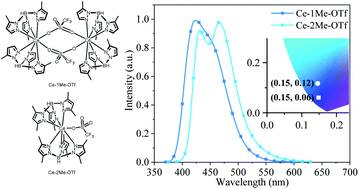Deep-blue emitting cerium(iii) complexes with tris(pyrazolyl)borate and triflate ligands†
Abstract
Red, green and blue emitting materials, the three primary colors, are very important in lighting and display. Red-emitting Eu(III) complexes and green-emitting Tb(III) complexes exhibit high color purity and photoluminescence (PL) efficiency. However, it is difficult to realize efficient blue emission based on f–f transition. Alternatively, Ce3+ with d–f transition can be used to construct blue-emitting lanthanide complexes. Herein, we synthesized two heteroleptic Ce(III) complexes Ce-1Me-OTf and Ce-2Me-OTf based on hydrotris(3-methylpyrazolyl)borate (TpMe) and hydrotris(3,5-dimethylpyrazolyl)borate (TpMe2) ligands, respectively, in which triflate is used as the ancillary ligand. Ce-1Me-OTf and Ce-2Me-OTf exhibit strong blue emission in dichloromethane and as powder with maximum emission wavelengths in the range of 424–436 nm. Both complexes demonstrate near-unity photoluminescence quantum yields (PLQYs) in powder and good sublimation properties. In particular, Ce-1Me-OTf emits deep blue light both in dichloromethane and as powder with Commission Internationale de l'Eclairage (CIE) coordinates of (0.15, 0.07) and (0.15, 0.06), respectively, which are close to the standard blue points recommended by the National Television System Committee (NTSC) and the European Broadcast Union (EBU).



 Please wait while we load your content...
Please wait while we load your content...